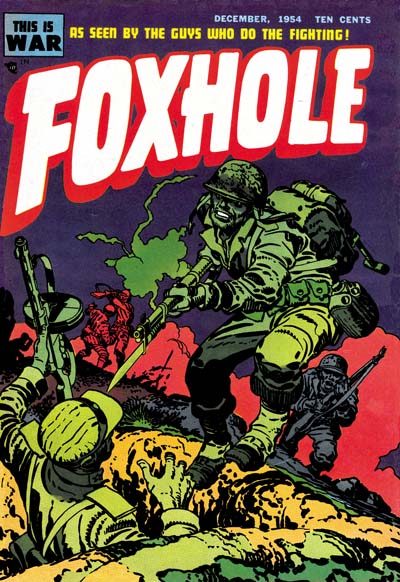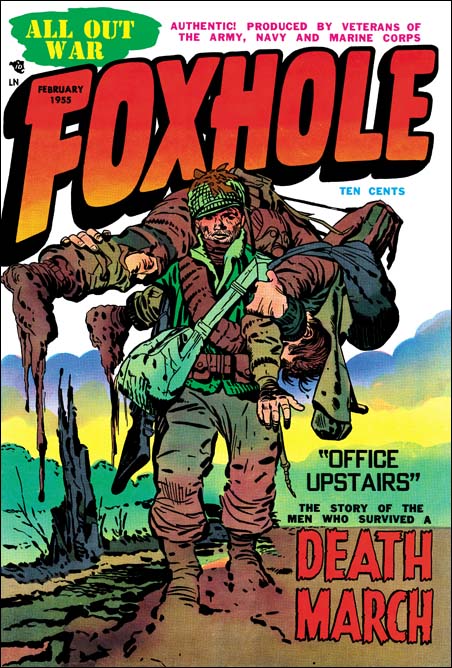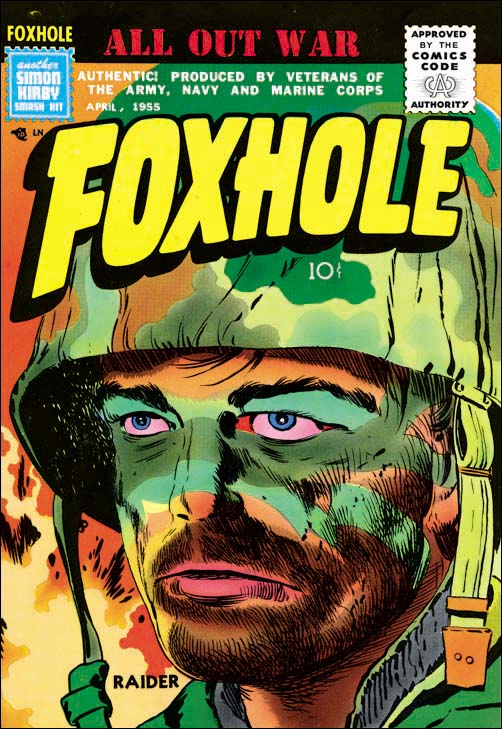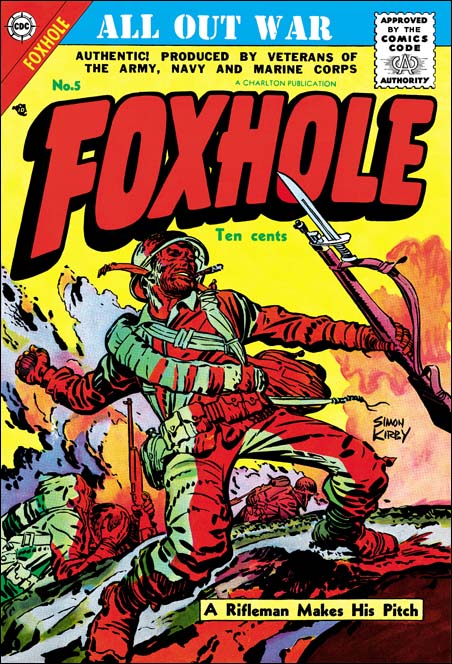
Foxhole #2 (December 1954), art by Jack Kirby
Giovanni Virginio Schiaparelli, an Italian astronomer and a careful observer, drew maps of Mars in the early 20th century. Surprisingly they showed straight lines crossing the surface. Later the American Percival Lowell repeated and improved on Schiaparelli’s observations. These linear lines were called canals. Some used the term just as a convenience while others felt that they really were artificial water conduits. The maps these scientists drew would be used in textbooks until the robotic probes arrived to provide high resolution photographs. These photographs showed that not only were there no artificial canals on Mars, the linear features mapped by Schiaparelli and Lowell could not be found at all.
When prehistoric cave wall paintings were discovered in France and Spain they posed a significant dating problem. Because they existed on walls, the usual dating techniques of archeologists could not be applied. After much study, some scientists proposed a relative chronology based on the art style. Basically crude paintings and engravings were considered the oldest remains, paintings only using black followed, and then color art with more complicate perspectives were considered as done in the final period. Not everyone agreed with the proposal, but to most scientists it seemed very reasonable. However in the 1990’s some new caves were discovered which could be dated accurately. The art made use of color and perspective that by the old scheme would have put it in the final period. Surprising the dating showed the art was created from a very early period instead.
I could provide further examples where reputable experts have made observations that in the end were shown to be completely false. You would think that experts would dispel false claims, not generate them. What gives? Humans, and that includes experts, have an amazing ability to recognize patterns. No computer has ever been able to match man in this capability. Unfortunately there is one important flaw in our skill; we find patterns even when none exist. This has been scientifically demonstrated over and over. People will find patterns in randomly generated numbers, or even flips of a coin. People are particularly susceptible to false patterns when they already suspect they are there. This is why Percival Lowell was able to “confirm” Giovanni Schiaparelli’s Martian canals. Experts are as prone to this difficulty as anyone else. But how can one distinguish between valid patterns and false ones? What is needed is independent evidence. Without such evidence, all “observed” patterns should be treated with skepticism.

Foxhole #3 (February 1955), art by Jack Kirby
It is just that sort of skepticism that is called for on the subject of Kirby Kolors. This is a belief, shared by a surprising number of experts, that they can identify those stories and covers where Jack Kirby was the colorist. To date none of these experts have ever offered anything to back up their claims. The only justification advanced was the numerous works by Kirby they had studied. The only explanation as to what they looked for was vague talk of some colors such as salmon that Jack is said to have preferred.
In order to dispel these mysteries and arrive at an understanding of the true nature of Kirby Kolors, it is best to begin with a review of how comic book colors were created in those days. Comics, just like almost all color publications, were printed using CMYK inks. CMYK stands for the colors used; Cyan, Magenta, Yellow and blacK. Combining different amounts of these inks can provide a very wide range of colors. Inks are actually printed as pure colors but the perception of gradients is created by printing small dots that cover varying amounts of the paper. At that time comic books were printed on rather primitive presses where the low printing costs were more important then color accuracy. Therefore most coloring was done using fixed measures for each of the CMY inks; 0%, 25%, 50% and 100%. Theoretically it would be possible to include 75% as well but that measure was rarely used for comic book publication, I suspect that with the crude printing presses it would frequently fill in and become indistinguishable from 100%. Note that I indicated the comic color palette was formed by three inks (CMY) and I did not include K. Black is theoretically redundant; it can be made by using 100% of the three other inks (CMY). However inks are not perfect; mixing CMY inks does not usually create a rich black so a separate black ink is generally used instead. The black ink could also be used in the three different gradients but doing so does not actually generate any new colors since the various grays that are formed can also made with gradients of CMY inks. With three basic inks (CMY) and four gradients (0%, 25%, 50%, 100%) it is possible to create at most 48 distinct colors. Actually colorists usually did not use the entire palette, some would be considered too muddy. Ted Klein has a blog entry showing what he used to use for his coloring work. What is important is that the comic book colorist had a very limited set of colors to choose from. With all the comics that the abundant colorists worked on, there is can be no doubt that every color in the comic palette would have been used by numerous colorists. Pick any color from an old comics and a careful search through enough comics will show that a single artist would not likely be responsible for all of that color’s use. The idea that Kirby’s color guides can be identified by the use of salmon (50% Magenta) makes no sense. Salmon color can be found in a number of comics that Jack Kirby had no involvement with.
Chess has a small number of pieces yet they can be used to produce an incredible number of possible games. It is not a perfect analogy, but it does suggest that rather then trying to use a single color to identify a colorist you might be able to do so by identifying how different combinations of colors are employed. The more combinations that are used the more likely you could uniquely identify a colorist. The trick then becomes attaching certain color patterns to a particular artist. Unfortunately throughout the period of the Simon and Kirby collaboration comics did not provide credits identifying any of the colorist. Even afterwards when credits became more common, Jack Kirby was never identified as the colorist for any published comic book work. For such a prolific artist, there are surprisingly small numbers of colored works by Kirby. Most of the coloring Kirby did was for proposals and not actual comics and came after better printing methods were adopted and the older limited comic palette was abandoned. Joe Simon did do a lot of color work for the covers of Sick, however those covers were printed with the better printing presses used for standard magazines and therefore were not based on color guides nor did they use the limited comic book color palette.

Foxhole #4 (April 1955), art by Jack Kirby
Since there are no comic credits or color guides examples that can provide support of the Kirby Kolor notion, what about evidence provided by people who worked with Jack? Well there is such evidence but it is not supportive of this myth. Joe Simon has stated that in the deal Simon and Kirby struck with Prize Comics, they were responsible for putting together all the art of a comic and it was up to Prize to do handling the publication aspect. When asked about who did the color guides, Joe would always answer that was the publisher’s job. This means that all the financial burdens of producing the comic art fell on Joe and Jack. Simon and Kirby would only recover their expenses by their share of the profits when the issue was released. Under this arrangement the idea that Jack would proceed to create color guides without getting paid for it seems a bit ludicrous.

Foxhole #5 (July 1955), art by Jack Kirby
Most of what Simon and Kirby did after the war was for Prize comics, but not all of the it. Of particular interest for Kirby Kolors are the comics published by Mainline. Mainline was Joe and Jack’s own comic company and therefore at some level they were responsible for having color guides made. That is not to say Joe or Jack personally created the color guides, if Joe’s attitude about coloring is any example they probably handed this task to someone else. Simon’s collection still has a few color guides for some stories from a later period. When I asked him if he had done the coloring Joe replied that although he might at times color a cover he would never do so for a story. This remark has particular interest because of four extraordinary covers for Foxhole, a title started by Mainline and finished by Charlton. The coloring used on these four covers are very unusual, I do not recall every seeing anything like them elsewhere. Although the line art is incredible, the coloring plays an important part of what makes these four covers so successful. The Foxhole cover coloring is so good that one could suspect that they were not done by any ordinary colorist but could be the work of either Jack or Joe. These are the only examples where the myth of Kirby Kolors may have some validity, even then only if the bias is adopted that if it was artistically good Jack must have done it. Considering how much color work Joe has done later in his career and how little Jack did, this does not seem like a reasonable assumption. Even so, acceptance of the Foxhole covers as Kirby Kolors would not form the foundation for finding other examples, the dramatic coloring of the covers are not found anywhere else in the Simon and Kirby oeuvre, including the Foxhole interior stories.
I am not naive enough to believe that this post means the end of Kirby Kolors. Kirby fans are so enthusiastic that some want to credit Jack with whatever successes they can. Fans find support for these efforts from comic book experts. The experts in turn are so absorbed in finding connections and patterns in comic books that they fail to recognize the lesson of the canals of Mars.


Yeah! Let’s hear it for good old skeptisism!
The most farfetched Kirby Kolor klaim I ever came across was the idea he did the colors for his work for Gilbert (I think it was the hunting book). The general consesus of this idea is that Jack Kirby preferred secondary colors, by the way. Orange, green, purple… they do turn up from time to time in his work. In fact, personally I dislike the amount of orange in some of his stories from the late fifties. And I hate even more being told I have to like it, because it was Jack’s personal choice.
Ger,
Skeptisism? LOL. I guess I was not strong enough in my writing. 😉
Salmon vs. orange, green, purple; does not matter.
My “favorite” Kirby Kolor klaim was from one of the leading proponents of this myth. It was a Super Comic reprint of Bullseye. The only problem was the coloring was different from when it was originally printed. So Jack was not the original colorist but somehow felt it necessary to color the Super Comic version. Go figure.
Harry